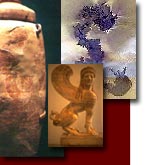| Site Map | Contacts | Links | Newsletter | |
CRSEF Expedition
CRSEF Expedition to the
Mountains of Pennsylvania
This report is written by Dr. Stephen Meyers of the Institute for Biblical and Scientific Studies who went along on the expedition. CRSEF, Creation Research, Science Education Foundation has a web site at http://www.worldbydesign.org. Hugh Miller was the leader of this expedition.
August 18, 2000
I started out from Philadelphia in the morning and headed up to Hazleton, PA to see the Hazleton Historical Society Museum, 55 North Wyoming Street. Their web site is at http://www.hazletonhistory.8m.com. At this museum are the "human fossils" that Ed Conrad had found in Pennsylvania coal. His web site is at http://www.edconrad.com/.
My comments and more pictures about this are at http://bibleandscience.com/conrad.htm. See also a published letter by Kurt Wise at http://www.geo.ucalgary.ca/~macrae/t_origins/carbbones/wise.html. For an evaluation of these bones see http://www.geo.ucalgary.ca/~macrae/t_origins/carbbones/carbbones.html.
August 19, 2000
Everyone meets at the Holiday Inn at Williamsport, PA at 8:30 am. During breakfast conversation I learned that public school teachers can not read or write, let alone speak English. This is why they are home schooling their kids. Secular history books are wrong because Abraham Lincoln was really a fascist. Below is part of the group at the Holiday Inn breakfast meeting.
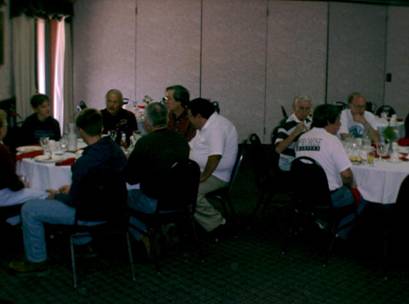
A table was set up to display the fossil footprints they had found. Three of them were casts of prints found at the Paluxy River in Texas. Below is a picture of one of these prints which does not look like a real footprint to me.
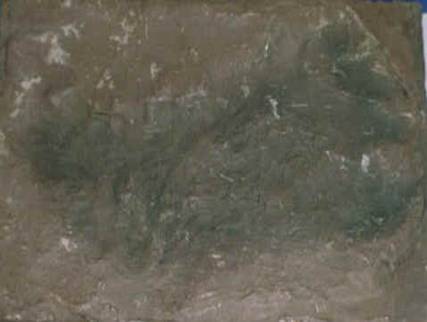
For more information about the tracks at Paluxy River see my web page Dinosaur and Human Prints in the Paluxy River.
Jacob Prints
The key rock with supposed human tracts that was found on McIntyre mountain led to this expedition to try to find more human tracts. Below is the picture of the rock dubbed the "Jacob prints" since it was found by the Jacob brothers.
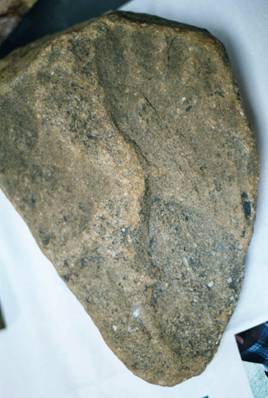
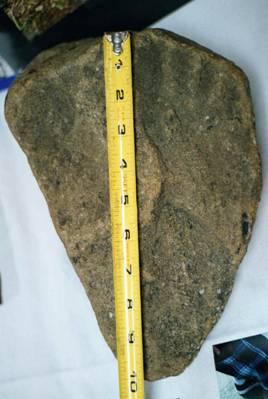
They claim there are two human footprints on this rock which they said it was sandstone. One large print of a women who bent down to pick up her baby, small upper left print. The large impression is 9and one half inches long and 3 inches wide in the middle. The toes are 3 and one half inches wide. Both prints do not look like a normal human footprint. First of all, there are only four toes. Secondly, the big toe is offset too far to the left. Thirdly, the heel is not on the same plain. Last of all, there is a raised bump below, between the big toe next toe. The supposed baby print does not look anything like a human print. There is no arch. The number toes is questionable, and the heel is a round circle shape.
Expert Opinions on the Jacob's Prints
Richard J. Sherwood, Ph.D.
Assistant Professor
Dept. of Anthropology
University of Wisconsin
Dr. Sherwood makes the following comments, "Human feet have two very unique features. The first is an adducted big toe, that is the big toe is in line with the other toes. Compare this to a monkey or ape whose feet look and act more like hands with a grasping big toe. The other feature is an arch. This allows the human foot to act as a shock absorber during bipedal locomotion. Because of this, as well as the peculiar mode of locomoting on two limbs, human footprints also have unique features. When a human walks the first phase is heel-strike. Because body weight is being transmitted initially through the heel alone heel strike tends to leave a deep impression. As the foot rocks forward force is transmitted primarily along the lateral (outside) margin of the foot. Force is then transmitted through the metatarsal heads or what is
normally known as the ball of the foot. The final phase is known as toe-off where the big toe is used for one final push. Like heel-strike, toe-off tends to leave a deep impression of the big toe and first metatarsal head.
Under certain circumstances animal prints will contain some of the features noted above. The are primarily due to the way the substrate behaves under their foot and not the anatomy of the foot. For instance ostrich prints
can be mistaken for human footprints as can bear prints. Again, this is not common but can happen especially if part of the print is obliterated. Finally, natural forces can leave imprints that can be mistaken for prints. Water activity, slow seismic activity (let's include glaciers in this as well) will often scar rocks leaving patterns. Humans
are particularly adept at seeing shapes in random patterns, that's why we see faces in cloud formations (or even tortillas) and butterflies in ink blots.
The pictures I have seen of the "footprint" are very bad. I see nothing resembling an infant footprint. There is a pattern that does look like a larger footprint but I don't believe it carries any of the hallmarks of a modern human footprint. I believe it is best explained as a random pattern on a rock. If the material is truly sandstone then it is likely due to the action of water during deposition.
Glacial Print
Pictures were on display of a supposed human print in glacial scarred rock in Ohio. I have seen other prints similar to this carved out by water in Ithaca, NY (To see these pictures click here). They are naturally occurring depressions. Note there are no toe impressions.
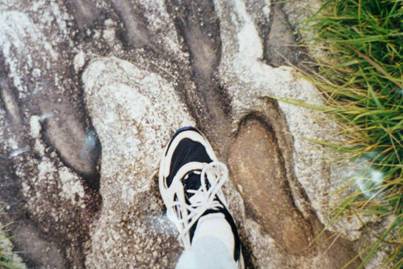
Acambaro Figurines
Pictures were passed around of dinosaur figurines from Acambaro, Mexico supposedly made by ancient Indians.
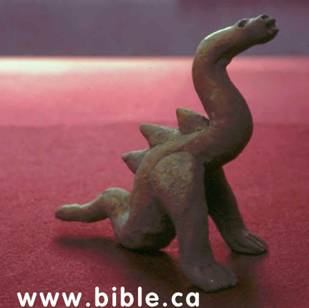
To see more pictures see http://www.bible.ca/tracks/tracks-acambaro.htm. Other scientists claim these are frauds made locally for tourists. First of all there is great debate about the authenticity of these artifacts. Secondly, this does not look like any known dinosaur. Thirdly, ancient cultures made up all sorts of monsters like the seven headed Leviathan. Fourthly, some may have come from finding fossil dinosaurs bones. There is an interesting book about this entitled The First Fossil Hunters written by Adrienne Mayor. See her interesting web site at http://homestead.deja.com/user.afmayor/indianfossilmyths.html
For more detailed analysis of the Acambaro figurines see http://bibleandscience.com/hovind.htm#acambaro
Dating Dinosaurs
I was also given a paper telling about the carbon 14 dating of four dinosaur bones. One was of an Allosaurus bone that was dug up by a team from Liberty University. Dr. Murray helped out with the excavation. For pictures of this excavation see http://bibleandscience.com/dinosaurhumanprints.htm . Dr. Murray prepared the bones for Liberty University. Dr. Murray tried to explain to them that there was no organic carbon in the bones. The bones were completely fossilized. All the original organic material is replaced by other minerals. So what was tested was not the original carbon in the bones. Dr. Murray prepares and preserves bones with gum Arabic. I asked Hugh Miller about gum Arabic and he said he knew nothing about it. They might have mistaken gum Arabic for collagen.
Hugh Miller said that CRSEF gave money to Russian scientists to extract collagen from dinosaur bones, but the money was instead given to pay off the Russian mafia.
Dr. Bartelt states, "According to Robert Kalin, a specialist at the University of Arizona's radiocarbon dating laboratory, Hugh Miller's fossils were not bone. Like most ancient fossils, the organic portion of the bone had long ago been replaced by minerals. The young "dates" are from contamination and/or carbon-containing preservatives (Lepper B. "Radiocarbon dates for dinosaur bones? A critical look at recent creationist claims." Creation/Evolution 1992. 30: 1-9)." See http://www.stear@onthenet.com.au/~stear/hovind_fractured_fairy_tales.htm
For more information on Carbon 14 dating see:
How good are those Young-Earth Arguments by Dave Matson
Radiometer Dating Resource List by Tim Thompson
After breakfast instructions were given. When hiking through the mountains beware of rattlesnakes, bears, and mountain lions. We were told how to distinguish between human footprints and bigfoot prints. The bigfoot prints have only three toes here in Pennsylvania. There is no arch with a wide middle and heel.
We then headed out and divided up into two groups. One group went up to Bodine Mountain, and the group I was with went up McIntyre Mountain.
The group that went up Bodine Mountain attempted to cast an impression that had only one toe. The plaster stuck to the rock so they had to break it up in pieces.
Our group went up McIntyre mountain where the "Jacob's prints" were found to see if we could find any more tracks. We parked where there were two protruding slabs of flat rock that looked like glacier marks. Hugh thought there were three human footprints on these slabs. The people in our group could not find any real human footprints. Look for yourself below.
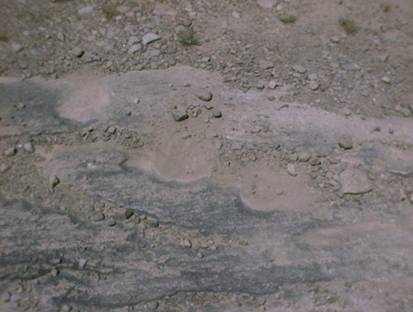
We then hiked down to the creek. There were rocks that looked like they were left by glaciers. I found at least ten rocks that looked like human prints, but everyone in the group realized they were not real human footprints. Below is an example of the impressions I found.
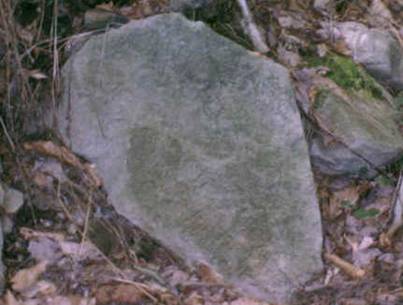
Looking for shapes in rocks is much like looking at clouds for shapes. You can see whatever you want to see. I did discover a rock with the letter "T" on it. Is this evidence of human activity or alien origin? No one in the group thought so. See below.
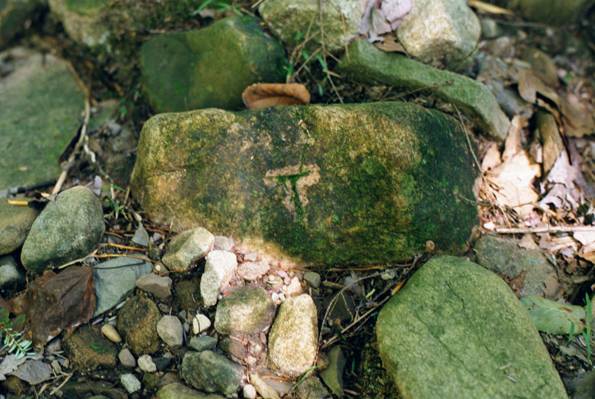
We hiked back to our cars disappointed that we did not find any real prints. Part of the group went back to the motel while another guy and I went to hunt for fossils. Along the roadside we found armor plates and bones from armor plated fish. The rocks are reddish in color while the bones are white. Hugh Miller wanted to carbon date these bones, but these are completely fossilized with no original carbon left.
We went to another place were we found many crinoid stems. When the rock is split open you can see the cross-section of the crinoid stem (round circles).
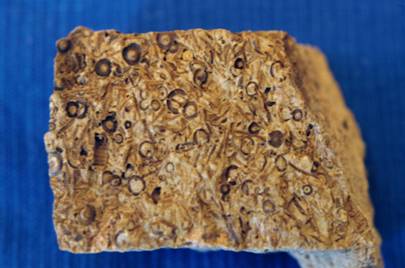
Later that night I discussed what our group did not find with Hugh Miller. I told him we did not find any human fossil prints. The impressions on the slabs were not human. The rocks were transported by glaciers, so he would not find a layer of rocks with a track way in them. Hugh did want to find more fish bones so he could carbon date them.
August 20, 2000
The group was going to go back up into the mountains to try and find bigfoot tracks, and other fossil animal tracks. Below is a supposed deer track.
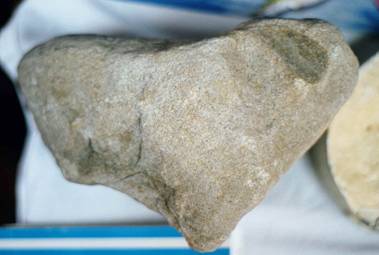
I asked him again about the difference between bigfoot and human footprints. I decided not to go chasing through the mountains after bigfoot, so I started back to Philadelphia. Along the way I stopped at an old quarry that had some interesting crinoid roots and other fossils. At first I thought the crinoid roots were cigarette butts. I finally arrived back in Philly with a trunk full of fossils.
Impressions near Ithaca, NY at Taughannock Falls
Taughannock Falls is the highest Falls East of the Mississippi (215 feet high). Below is an impression in the rock near the falls that looks like a human foot print, but was naturally carved out by water.
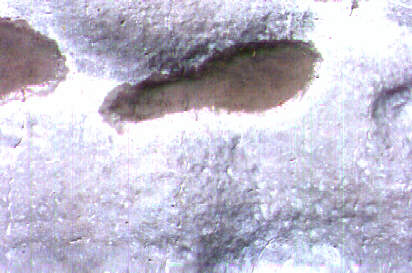
There are many shapes created by the water. How many more human like impressions can you find?
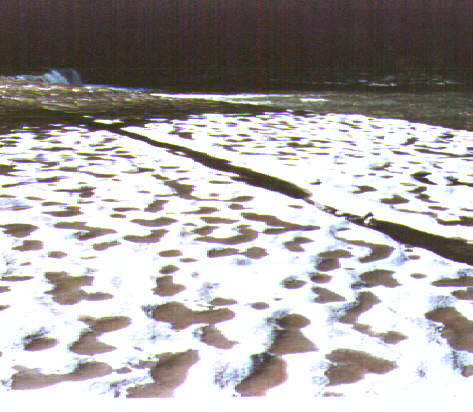
Below is a picture of Taughannock Falls.
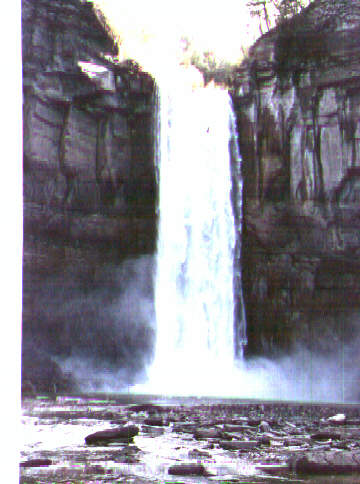
A Carved Footprint from Kentucky
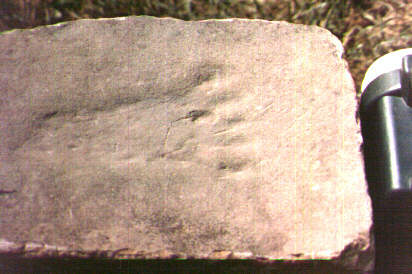
For other supposed footprints from Berea, Kentucky see http://www.talkorigins.org/faqs/berea/berea.html
The Burdick Track
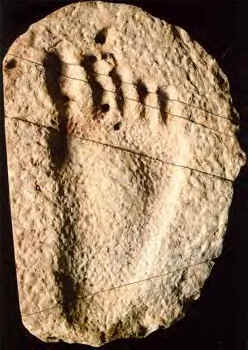
This is also a carved footprint that some creationist still claim is real. It is from the Paluxy River near Glen Rose, Texas. There is a detailed analysis of this print at http://members.aol.com/Paluxy2/wilker5.htm
The Caldwell Cast
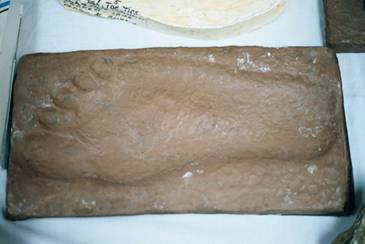
Marian Talyor said that the Taylors purchased Caldwell's cast in Glen Rose in the 1960's and knew it to be from a carving. She also expressed displeasure about Carl Baugh's false claims that it is a real human footprint. Grover C. Gibbs, Jr. could not substantiate Baugh's claims. Jacob McFall said that the print was a carving done by one of the Adams brothers during the Depression (Creation/Evolution Issue 17, Vol.6, No.1, pages 25-26).
The Carboniferous Mystery
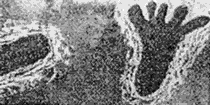
This article and image appeared in Scientific American, vol. 162, January 1940, page 14. This article does not claim there are human foot prints in Carboniferous rocks. The prints do not even look like human footprints. These prints were found in Berea, Kentucky.
David I. Bushnell of the Smithsonian Institute states, "unquestionably a carving made by the Indians" (p.14). Another opinion was that the prints were made by a giant toe-like amphibian.
The article concludes, "What science does know is that....these prints were not made by any Carboniferous Period man" (p.14).
For more pictures see http://www.talkorigins.org/faqs/berea/index.html
For a detailed study of these prints see "Creationism, Human Footprints, and Flood Geology" by James Stewart Monroe in Journal of Geological Education Volume 35, Number 2, March 1987, 93-103.
E-mail: info@bibleandscience.com
